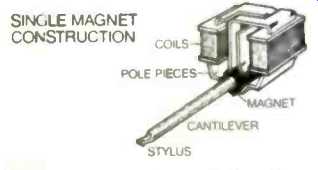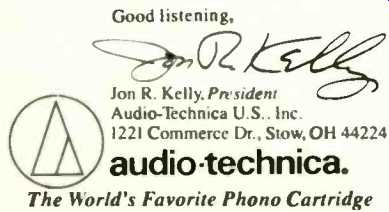
audio-talk from audio-technica -- Number 9 in a Series
Two is Perfect!
Getting two signals from the single groove of a stereo record is the job of the magnet/ coil structure inside the stereo phono cartridge. The stereo signals are recorded at 90° to each other, and at 45° to the surface of the record. Each groove wall has its own recorded pattern intended to be sensed independently of the other.

The Crowded Single Magnet
In ordinary moving magnet cartridges, a single magnet is located at the end of the stylus cantilever. Packed tightly around it are two pairs of pole pieces. Each pair senses the changing magnetic flux as the magnet is moved in response to the stylus motion from "its side" of the record groove.
But because the pole pieces must be very close to the magnet to sense the changes, they must also be very close to each other.
A Problem to be Solved
Audio-Technica engineers noted the crowding, with its danger of electrical crosstalk which could reduce stereo separation. They were also concerned with minimizing magnet size, but a single magnet had to be large enough to accommodate both pairs of pole pieces. And then they found a better way.
The A-T Solution

Their response was to create the unique Vector-Aligned magnet structure exclusive to Audio-Technica cartridges. By using two very small magnets, aligned to mirror the geometry of the original recording cutter, they eliminated the crowding, reduced the moving mass, and improved both stereo separation and high frequency response. The magnets could be located just in front of the pivot point, further reducing moving mass and greatly increasing the overall stiffness of the assembly.
In our next column we'll discuss in detail why two magnets is the ideal number for stereo reproduction.

Good listening,
Jon R. Kelly, President' Audio-Technica U.S.. Inc.
1221 Commerce Dr., Stow, OH 44224 audio-technica, The World's Favorite Phono Cartridge
(Adapted from Audio magazine, Nov. 1984)
Also see:
audio-talk from audio-technica -- Number 11 in a Series (Jan. 1985)
audio-talk from audio-technica -- Number 8 in a Series (Oct. 1984)
audio-talk from audio-technica -- Number 7 in a Series (Sept. 1984)
audio-talk from audio-technica -- Number 4 in a Series (June 1984)
Audio-Technica AT15Sa cartridge (Feb. 1977)
= = = =